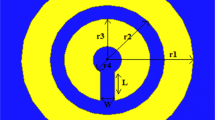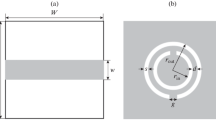Abstract
This article explored the design and implementation of rectangular split ring resonator (SRR) based microstrip bandpass filter for mobile Wi-MAX, WBAN and ISM band applications. A novel rectangular SRR based unit cell analysis with respect to permittivity, permeability, refractive index, and absorption rate are carried out using the Ansys HFSS. Flexible polyimide is used as substrate and the designed CSRR is placed in the implementation of the bandpass filter models. Initial design is of microstrip line-based radiating element with CSRR ground to operate at 3.2, 4.8, and 5.8 GHz. The second model is of SRR structure based radiating element bandpass filter to operate at 2.1, 3.9, and 5.7 GHz, respectively. The conformality of both bandpass filters across 15°, 30°, 45°, 60° and 90° bending are analyzed and found negligible variation in the performance characteristics. Prototyped microstrip bandpass filter results are measured using ANRITSU-MS2037C combinational analyser and found suitable validation with simulation results.
















Similar content being viewed by others
REFERENCES
1. V. G. Veselago, “The electrodynamics of substrate with simultaneously negative values of ε and µ,” Sov. Phys. Usp. 10, 509–514 (1968).
J. B. Pendry, A. J. Holden, D. J. Robbins, and W. J. Stewart, “Magnetism from conductors and enhanced nonlinear phenomena,” IEEE Trans. Microwave Theory Tech. 47, 2075– 2084 (1999).
D. R. Smith, D. C. Vier, W. Padilla, S. C. N. Nasser, and S. Schultz, “Loop-wire for investigating plasmons at microwave frequencies,” Phys. Lett. 75, 1425–1427, (1999).
D. R. Smith, W. Padilla, D. C. Vier, S. C. N. Nasser, and S. Schultz, “Composite medium with simultaneously negative permeability and permittivity,” Phys. Rev. Lett. 84, 4184–4187 (2000).
R. A. Shelby, D. R. Smith, and S. Schultz, “Experimental verification of a negative index of refraction,” Science 292, 77–79 (2001).
R. Marqués, J. D. Baena, J. Martel, F. Medina, F. Falcone, M. Sorolla, and F. Martin, “Novel small resonant electromagnetic particles for metamaterial and filter design,” in Int. Electromagn. Adv. Applicat. Conf., Turin, Italy, 8 (12), 439–442, (2003).
A. Grbic and G. V. Eleftheriades, “Overcoming the diffraction limit with a planar left-handed transmission-linelens,” Phys. Rev. Lett. 92, 117403 (2004).
S. Lim, C. Caloz, and T. Itoh, “A reflecto-directive system using a composite right/left-handed (CRLH) leaky-wave antenna and heterodyne mixing,” IEEE Microwave Wireless Compon. Lett. 14 (4), 183–185 (2004).
C. Caloz, A. Sanada, and T. Itoh, “A novel composite right/left-handed coupled-line directional coupler with arbitrary coupling level and broad bandwidth,” IEEE Trans. Microwave Theory Tech. 52, 980–992 (2004).
Y. Horii, C. Caloz, and T. Itoh, “Super-compact multilayered left-handed transmission line and diplexer application,” IEEE Trans. Microwave Theory Tech. 53, 1527–1534 (2005).
I. Lin, M. De Vincentis, C. Caloz, and T. Itoh, “Arbitrary dual-band components using composite right/left-handed transmission lines,” IEEE Trans. Microwave Theory Tech. 52, 1142–1149 (2004).
A. Lai, C. Caloz, and T. Itoh, “Composite right/lefthanded transmission line metamaterials,” IEEE Microwave Mag. 9, 34–50 (2004).
C. Caloz and T. Itoh, “A novel mixed conventional microstrip and composite right/left-handed backward- wave directional coupler with broadband and tight coupling characteristics,” IEEE Microwave Wireless Compon. Lett. 14 (1), 31–33 (2004).
N. Engheta, “An idea for thin sub-wavelength cavity resonators using metamaterials with negative permittivity and permeability,” IEEE Antennas Wireless Propag. Lett. 1 (1), 10–13 (2002).
T. Decoopman, O. Vanbesien, and D. Lippens, “Demonstration of a backward wave in a single split ring resonator and wire loaded tinline,” IEEE Microwave Wireless Compon. Lett. 14 (11), 507–509 (2004).
A. Grbic and G. V. Eleftheriades, “Periodic analysis of a 2-D negative refractive index transmission line structure,” IEEE Trans. Antennas Propag. 51, 2604–2611 (2003).
R. W. Ziolkowski and N. Engheta, “Metamaterial special issue introduction,” IEEE Trans. Antennas Propag. 51, 2546–2549 (2003).
S. A. Cummer, “Simulated causal subwavelength focusing by a negative refractive index slab,” Appl. Phys. Lett. 82, 1503 (2003).
J. Bonache, F. Martin, F. Falcone, J. Garcia, I. Gil, T. Lopetegi, M. A. G. Laso, R. Marques, F. Medina, and M. Sorolla, “Super compact split ring resonators CPW bandpass filters,” in IEEE MTT-S Int. Microwave Symp. Dig., Jun. 6–11, 2004, (IEEE, New York, 2004), vol. 3, pp. 1483–1486.
J. Bonache, I. Gil, J. Garcia-Garcia, and F. Martin, “Complementary split ring resonators for microstrip diplexer design,” Electron. Lett. 41, 810–811 (2005).
Rezaei, Abbas, Salah I. Yahya, and Mohd H. Jamaluddin. “A novel microstrip diplexer with compact size and high isolation for GSM applications,” AEU-Int. J. Electron. Commun. 114, 153018 (2020).
Q. Liu, D. F. Zhou, D. W. Zhang, D. L. Lu, and Y. Zhang, “Dual-mode microstrip patch bandpass filters with generalized frequency responses,” IEEE Access 7, 163537–163546 (2019).
M. Challal, A. Mermoul, and K. Hocine, “High-frequency microstrip dual-band bandpass filter fabricated using FR-4 glass epoxy material,” J. Phys. D: Appl. Phys. 50, 495602 (2017).
S. Moitra and R. Dey, “Design of dual band and tri-band bandpass filter (BPF) with improved inter-band isolation using DGS integrated coupled microstrip lines structures,” Wireless Personal Commun. 110, 2019–2030 (2020).
Mouloud Challal, Kenza Hocine, and Ali Mermoul. “A novel design of compact dual-band bandpass filter for wireless communication systems,” Wireless Personal Commun. 109, 1713–1726 (2019).
ACKNOWLEDGMENTS
Authors express their gratitude towards Department of Science and Technology for the technical support through SR/FST/ET-II/2019/450.
Author information
Authors and Affiliations
Corresponding author
Ethics declarations
The authors declare that they have no conflicts of interest.
Rights and permissions
About this article
Cite this article
Vineetha, K.V., Madhav, B.T., Kumar, M.S. et al. Analysis of Conformal and Metamaterial Based Microstrip Bandpass Filter for Wi-MAX, WBAN and ISM Band Applications. J. Commun. Technol. Electron. 67, 443–455 (2022). https://doi.org/10.1134/S1064226922040118
Received:
Revised:
Accepted:
Published:
Issue Date:
DOI: https://doi.org/10.1134/S1064226922040118




